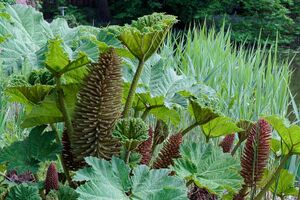Gunnera Cyanobacteria symbiosis
Gunnera

Cyanobacteria
Cyanobacteria are the largest phylum of Gram-positive prokaryotes on earth. They are known for their ability to obtain energy through photosynthesis [1]. The ability to produce oxygen is believed to be an attribute to their success in evolution because the environment in which they were developing was otherwise occupied by anaerobic bacteria. For this reason, Cyanobacteria are attributed to causing the Great Oxidation Event where the earth first experienced a rise in the amount of oxygen [2].
Many species live in large colonies of cells ranging from hundreds to thousands of cells in a single colony [3]. These colonies are able to form filaments, sheets, or hollow spheres [4]. When too large, they can form harmful algal blooms that can cause great harm to the aquatic ecosystem and the surrounding area it is in [5].
Cyanobacteria are wide spread around the world, contributing to major global biogeochemical cycles like cellular death [6].
Gunnera and Cyanobacteria symbiosis
Include some current research, with a second image.
Conclusion
Overall text length (all text sections) should be at least 1,000 words (before counting references), with at least 2 images.
Include at least 5 references under References section.
References
- ↑ Sinha, R. P., & Häder, D. P. (2008). UV-protectants in cyanobacteria. Plant Science, 174(3), 278-289.
- ↑ Whitton, B. A. (Ed.). (2012). Ecology of cyanobacteria II: their diversity in space and time. Springer Science & Business Media.
- ↑ Tamulonis, C., Postma, M., & Kaandorp, J. (2011). Modeling filamentous cyanobacteria reveals the advantages of long and fast trichomes for optimizing light exposure. PLoS One, 6(7), e22084.
- ↑ Aguilera, A., Klemenčič, M., Sueldo, D. J., Rzymski, P., Giannuzzi, L., & Martin, M. V. (2021). Cell death in Cyanobacteria: current understanding and recommendations for a consensus on its nomenclature. Frontiers in Microbiology, 12, 416.
- ↑ Paerl, H. W., & Otten, T. G. (2013). Harmful cyanobacterial blooms: causes, consequences, and controls. Microbial ecology, 65(4), 995-1010.(Pearl and Otten)
- ↑ Aguilera, A., Klemenčič, M., Sueldo, D. J., Rzymski, P., Giannuzzi, L., & Martin, M. V. (2021). Cell death in Cyanobacteria: current understanding and recommendations for a consensus on its nomenclature. Frontiers in Microbiology, 12, 416.
Edited by Rachael Tomasko, student of Joan Slonczewski for BIOL 116 Information in Living Systems, 2021, Kenyon College.
